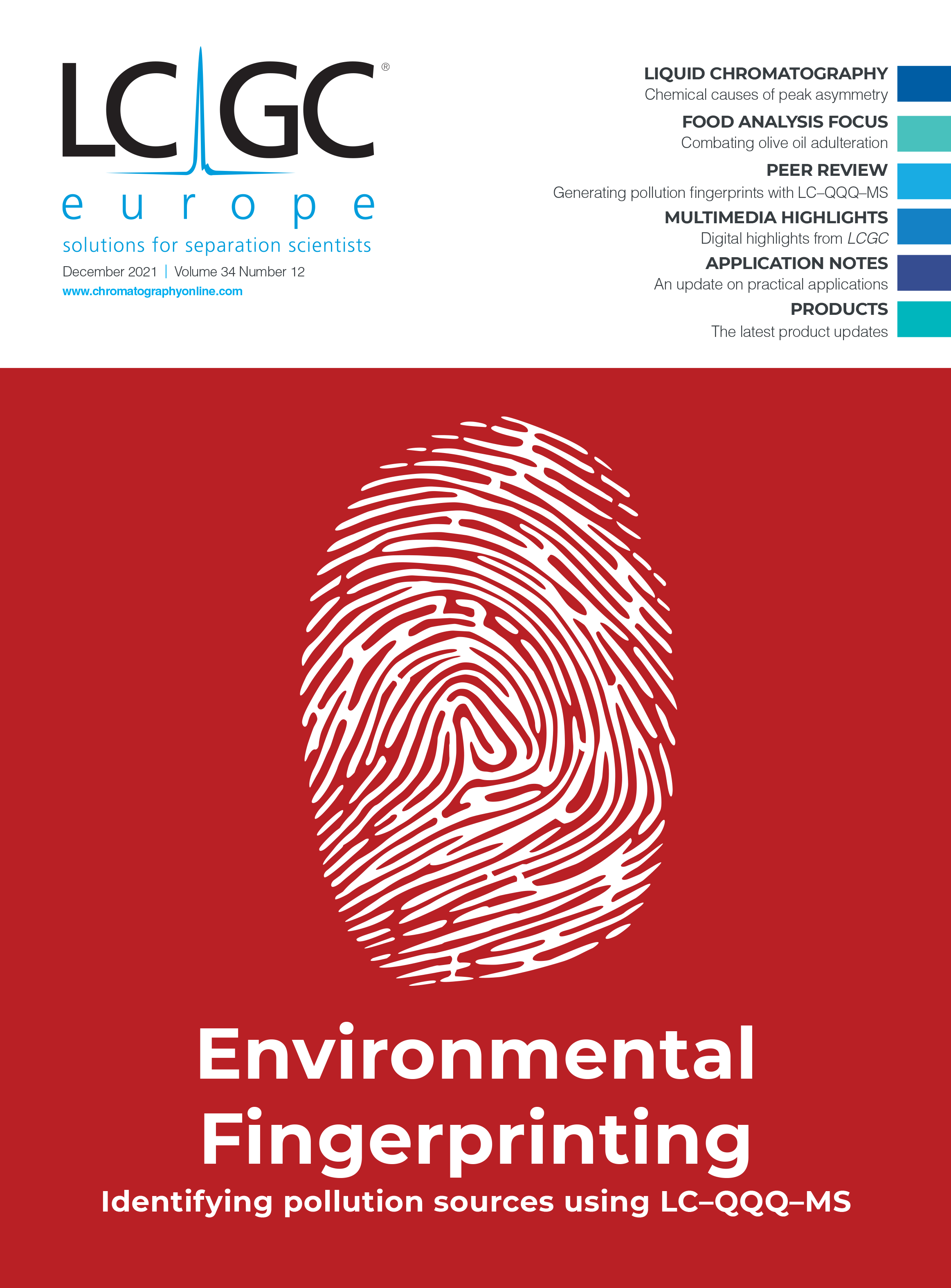Groundwater CSI: Unravelling Pollution Sources in Complex Environments with Liquid Chromatography Triple Quadrupole Mass Spectrometry
Wastewater treatment plants (WWTP) are used worldwide to purify domestic and industrial wastewater before it is returned to the environment. Even after treatment, wastewater may still contain a variety of contaminants, including nutrients (usually nitrogen and phosphorus) and organic pollutants, such as endocrine disruptors and pesticides. These compounds can leak into groundwater via old and/or damaged infrastructure, leaching from biosolids storage areas and/or release of effluents. However, similar contaminant impacts can come from other sources, such as agriculture. It is often very difficult to distinguish the true source of such contamination, especially where wastewater treatment plants are located in agricultural areas. Robust and sensitive techniques are needed to characterize impacts where there are multiple potential sources. This study analyzed a variety of synthetic chemicals using liquid chromatography triple quadrupole mass spectrometry (LC–QQQ–MS) to generate unique fingerprints of pollution. These were used to distinguish the impact on the local groundwater of a WWTP in southeast Victoria (Australia) from that of local agriculture. The use of such novel tracers could become a valuable tool in environmental monitoring, management, and remediation in the future.
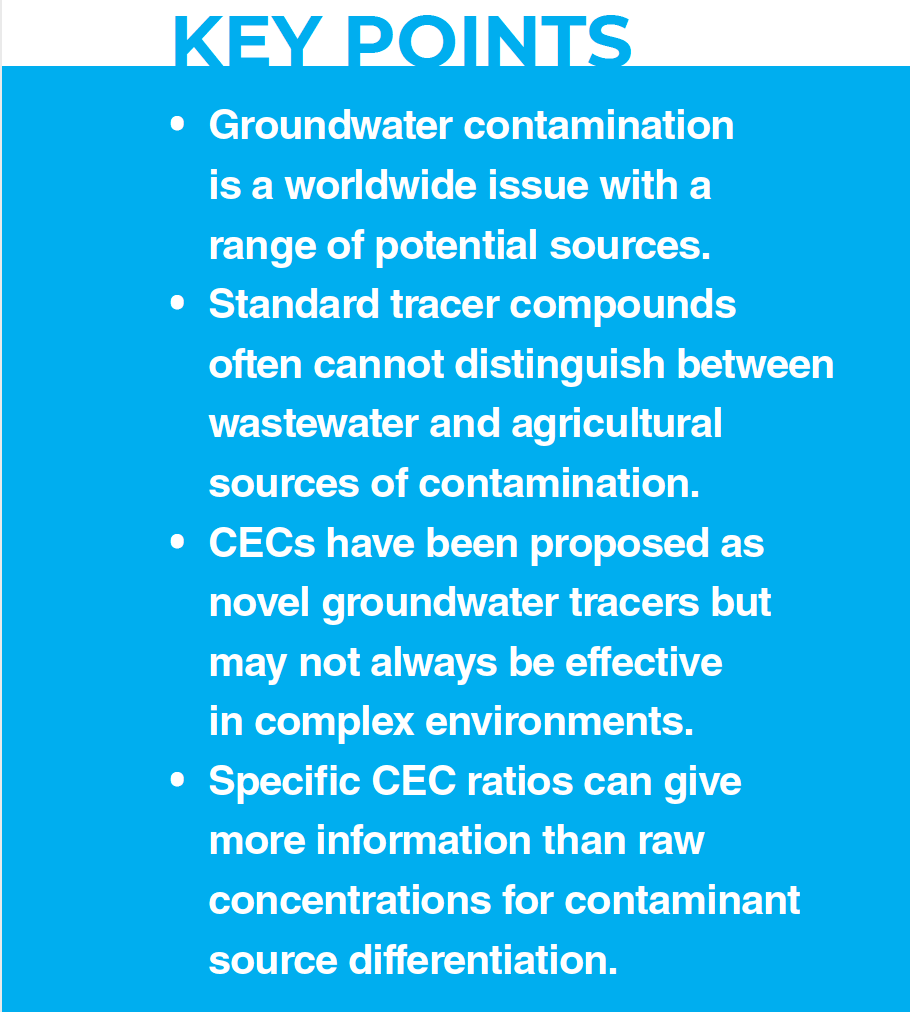
The water industry in most countries must comply with strict legislative controls on what they can and cannot discharge into the environment. Such legal requirements apply not only to the final effluent but also include potential impacts on the local environment from the plant itself. Such impacts could occur from leakage of untreated or partially treated wastewater from treatment infrastructure (for example, from old or damaged pipework and/or improper or damaged liners), lined treatment lagoons, and/or discharge of untreated effluents during periods of high-water flow, for example, after heavy rain. However it gets there, insufficiently treated wastewater can be a source of several differing types of pollutants to the environment, including synthetic chemicals, such as Contaminants of Emerging Concern (CECs) and natural inorganic substances, such as nutrients, primarily nitrogen and phosphorous.
CECs is a general term covering a broad class of compound classes, including pharmaceuticals, personal care and/or household cleaning products, flame retardants, and agricultural chemicals. They are classified as “emerging” because they have often, though not always, only recently been identified in various environmental matrices (usually at the ng/L to ug/L levels) through advances in analytical methodology, or in many cases are not yet regulated or monitored. Many are recalcitrant and, since wastewater treatment plants (WWTPs) are generally not specifically designed to remove them, they can pass though WWTPs and into the environment.
Despite many CECs being predominantly unregulated, a number of these compounds are beginning to attract attention due to their potential impacts on both human health and the environment, pertinent examples being per- and polyfluorinated substances (PFAS) (1) and disinfection by-products (2). Some CECs are new, such as the recently identified 6PPD-quinone (reported to be the cause of major die-offs of U.S. Pacific Northwest coho salmon [Oncorhynchus kisutch]) (3). Others are perhaps better classed as contaminants of re-emerging concern since their presence has been known about for many years but they have only recently come to mainstream attention. For example, the presence of pharmaceutical substances in the environment has been reported since the 1970s (4). CECs are consistently found in groundwater, surface water, municipal wastewater, drinking water, soil, and food sources. The persistence of these chemicals is a threat because they can potentially bioaccumulate.
Although it does not get as much press attention as CECs, nutrient pollution is a widespread, costly, and challenging environmental problem that can have diverse and far-reaching impacts on public health, the environment, and the economy. Nutrients such as nitrates and phosphates are naturally occurring compounds, but the way we concentrate and use them isn’t and this is what leads to problems. Excess nutrients in water bodies can cause algal blooms that severely reduce or eliminate oxygen in the water, potentially leading to the deaths of large numbers of aquatic organisms. Some algal blooms can produce toxins that can cause serious illness in humans and wildlife. High levels of nitrate in drinking water can also be dangerous to health, especially for infants and pregnant women.
Nutrient pollution can come from agriculture, a significant source of pollution in many countries (5). CECs may also enter the environment from farming if recycled water is used for irrigation and/or biosolids are used without adequate precautions (biosolid regulations usually don’t regulate CECs so the presence and concentration of these compounds in biosolids often isn’t known). Conventional monitoring methods such as major ions (analyzed via ion chromatography [IC]) and stable isotopes (analyzed via isotope ratio mass spectrometry or cavity ring-down spectrometry) are therefore often unable to distinguish between individual contaminant sources. In complex environments with multiple potential sources, this can be a particularly challenging task. This is a problem, as constraining the nature and extent of contamination is essential if remediation actions are to be fair and effective. This is particularly relevant for WWTPs located in urban, peri-urban, or intensively cultivated agricultural areas. In such areas, multiple potential contamination sources, such as livestock, fertilizers, wastewater irrigation, and domestic septic systems, may all contribute similar contaminants and so make the identification of the origins and pathways of contamination—and hence, determining suitable management and/or remediation strategies—exceedingly difficult (6). What is needed to overcome current limitations is a way to fingerprint pollution more definitively in order to identify the source. This is the objective of the current work.
Recent advances in separation science techniques have enabled the potential use of CECs to provide a more definitive assessment of contaminant sources, plume delineation, and even (potentially) indicating the age of contamination (recent versus legacy), even when present at trace levels (7–10). The suitability of compounds to act as novel groundwater tracers is evaluated according to four key criteria (6):
- Have a sufficient presence in raw wastewater and/or treated effluents and/or groundwater to be detected regularly;
- Diagnostic of WWTP and/or agricultural impacts as opposed to other potential off-site contamination sources;
- Persistent in the subsurface environment; and
- Amenable to rapid and sensitive analysis (since fast analysis is required by industry).
Several CECs including pharmaceuticals (carbamazepine, crotamiton, primidone, atenolol sulfamethoxazole, and acesulfame), pesticides (cyclamate and simazine), and artificial sweeteners (acesulfame, sucralose, and saccharin) have been identified to meet a number of these criteria. However, in many cases these are not all the subject of regular monitoring—if they are monitored at all. Groundwater can also be surprisingly complex as an analytical matrix, resulting in matrix effects and a reduction in analytical sensitivity. The study therefore required the development of advanced analytical methods for the trace analysis of these compounds in environmental matrices, in addition to a detailed understanding of the site and the associated hydrogeology.
The aim of the work was to be able to differentiate groundwater contamination from wastewater and agriculture sources in sites where both sources may be present.
Methods
Study Site: The study was conducted at a WWTP located approximately 100 km south of the city of Melbourne, in South‑Eastern Australia, that sits on an aquifer subject to numerous extractive uses, mostly associated with local agricultural activities. Groundwater within the region flows from the upper portions of the catchment—with predominantly agricultural land uses—beneath the WWTP and towards a conservation area and groundwater-dependent wetland ecosystem located adjacent to the site. Potential also exists for a local groundwater flow component towards a small stream (an ephemeral surface water feature), located to the west of the site. The area is well served with groundwater monitoring bores to enable the measurement of water flows and monitoring of possible contamination. Distinguishing potential contamination sources in this area is further complicated by the fact that treated recycled water from the plant is used for irrigation purposes in the agricultural area. This recycled water (and any contaminates within it) may therefore percolate down to the underlying groundwater.
Analytical Methods: CECs represent some of the most challenging compounds in environmental chemistry, due to their diverse occurrence, properties, fate, and concentration in different environments. These compounds are generally present in the µg/L or ng/L concentration range or lower. This means that suitable tracer compounds may occur in groundwater at levels close to their detection limits, requiring sensitive detection methods and (often) sample pretreatment, not to mention the often-complex matrix, such as wastewater, with many competing compounds. As a result, gas chromatography (GC) and liquid chromatography (LC) coupled with mass spectrometry (MS), or tandem mass spectrometry (MS/MS) are most widely used in the determination of CECs.
Samples for CEC analysis (carbamazepine, crotamiton, primidone, atenolol sulfamethoxazole, acesulfame, sucralose, saccharin, cyclamate, and simazine) were field filtered through 0.45‑μm in-line filters following the collection of samples for routine water quality analysis and collected in pre‑cleaned amber glass bottles (see Figure 1). Amber glass was used to reduce the degradation of light-sensitive compounds during transport. All bottles were preconditioned with an ethanol, ultrapure water, and acetone triple rinse followed by oven baking at 150 °C for a minimum of 2 h. Once collected, samples were preserved below 4 °C and transported to RMIT University’s analytical laboratory for analysis.
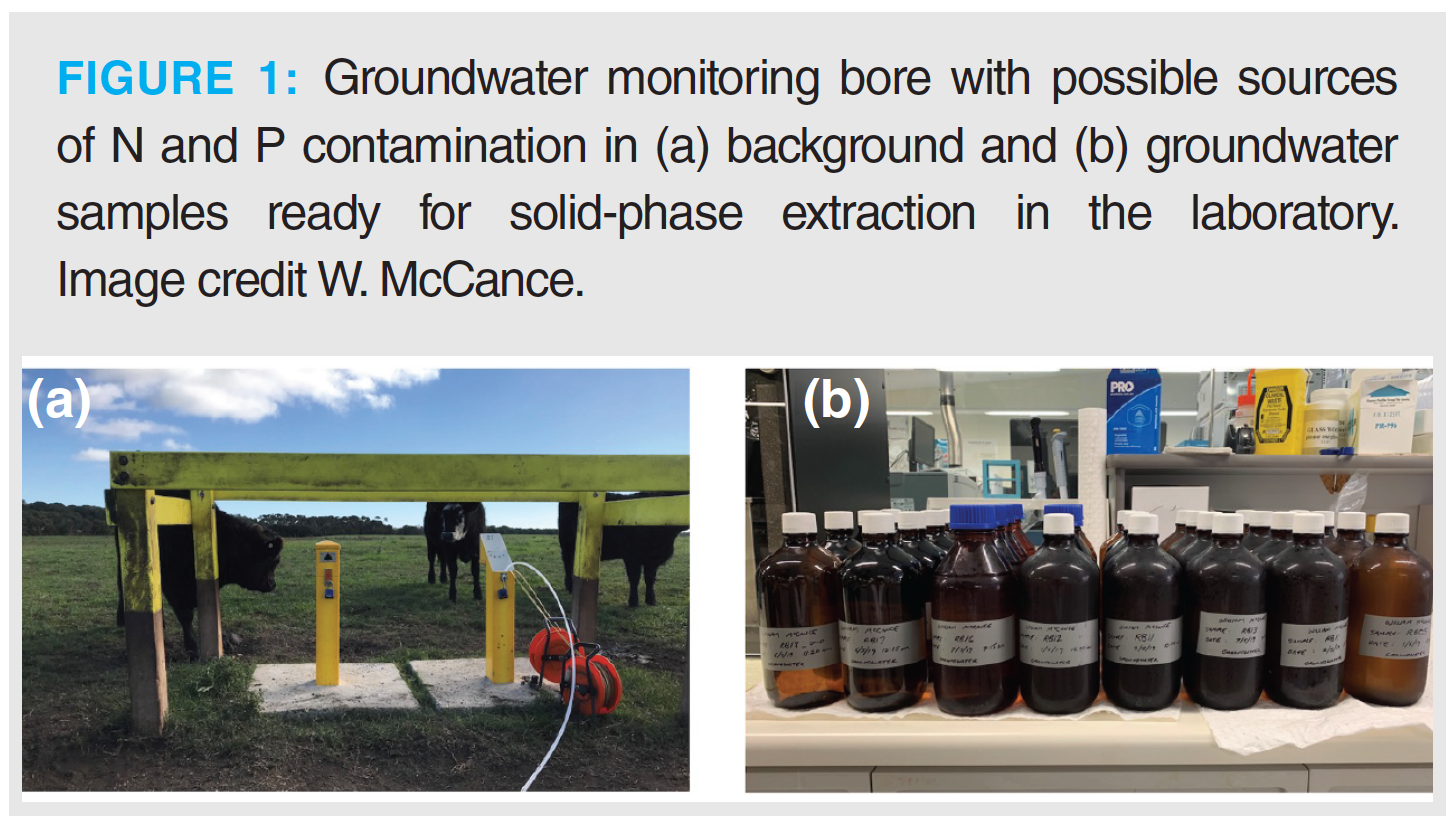
The solid-phase extraction (SPE) method was based on the validated method of Van Stempvoort (11) with minor modifications. All SPE cartridges were first preconditioned using 2 × 3 mL of methanol followed by 2 × 3 mL of Milli-Q water, with samples drawn though the cartridges at a rate of ~2.5–5 mL/min. A 900-mL aliquot of each sample was then spiked with analytical surrogates (deuterated and/or 13C labelled versions of the compounds under study) prior to extraction through Oasis HLB 6 cc (500 mg, Waters) SPE cartridges using a vacuum manifold.
Once the sample was passed through, the SPE cartridges were allowed to dry under vacuum for approximately 5 min and then the target compounds were eluted with 2 × 1 mL 50:50 methanol–acetonitrile followed by 2 × 1 mL 75:25 acetonitrile–Milli-Q water source to ensure all compounds were removed. Eluents were collected in 15 mL plastic centrifuge tubes and evaporated to near dryness under nitrogen. Once dry, extracts were then reconstituted using the starting mobile phase of the liquid chromatography system, as shown in Table 1.
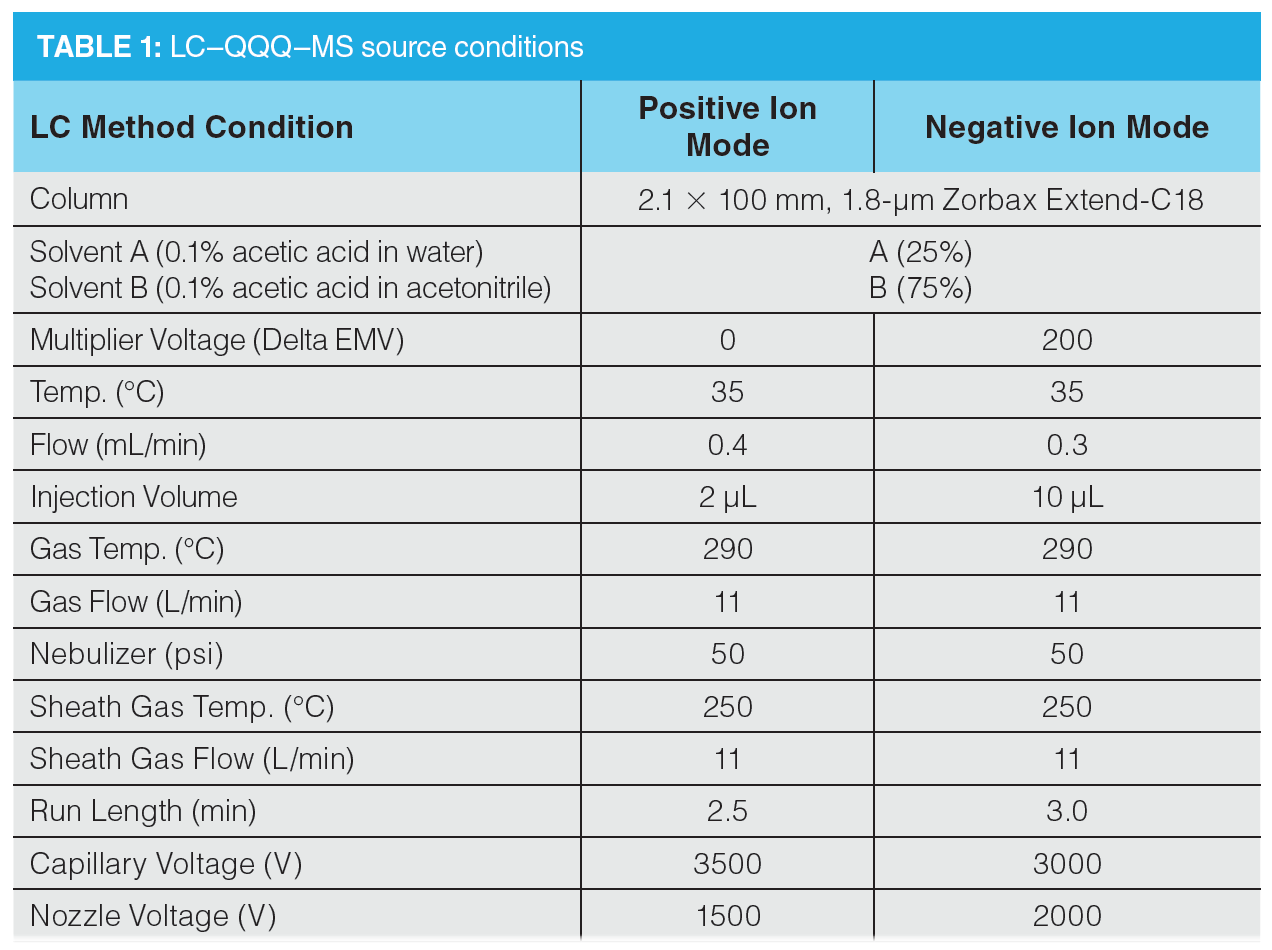
Once extracted, samples were analyzed using liquid chromatography hyphenated to triple quadrupole mass spectrometry (LC–QQQ–MS). This system was composed of an Agilent 1260 Infinity LC system, coupled to an Agilent 6490 Triple Quad MS using positive and negative ion monitoring mode. The operating and multiple reaction monitoring (MRM) conditions are outlined in Tables 1 and 2.

Results
It was impossible to use standard tracers such as nutrients (N and P) to distinguish wastewater-derived sources of groundwater contamination in the vicinity of the WWTP under study. This is illustrated in Figure 2, where it can clearly be seen that while there appears to be elevated nitrogen in the groundwater around the WWTP, there is also a similar level of elevated nitrogen up-gradient from the plant coming from the surrounding agricultural land.

Of the 10 compounds selected for analysis, only three were able to be quantified in the sample matrix, with signal-to-noise ratios sufficient to enable reliable detection and quantification. These were the pharmaceuticals, carbamazepine and sulfamethoxazole, and the pesticide, simazine.
Simazine was the most commonly detected compound, being identified in all samples. Carbamazepine was detected in 13 of 20 groundwater samples and sulfamethoxazole in one. Concentrations of these compounds ranged from <10 to 175 ng/L and groundwater reporting concentrations ranged from <1 to 253 ng/L (Table 3). The observed concentrations are broadly consistent with previous research on CECs in groundwater affected by WWTP sites (11).
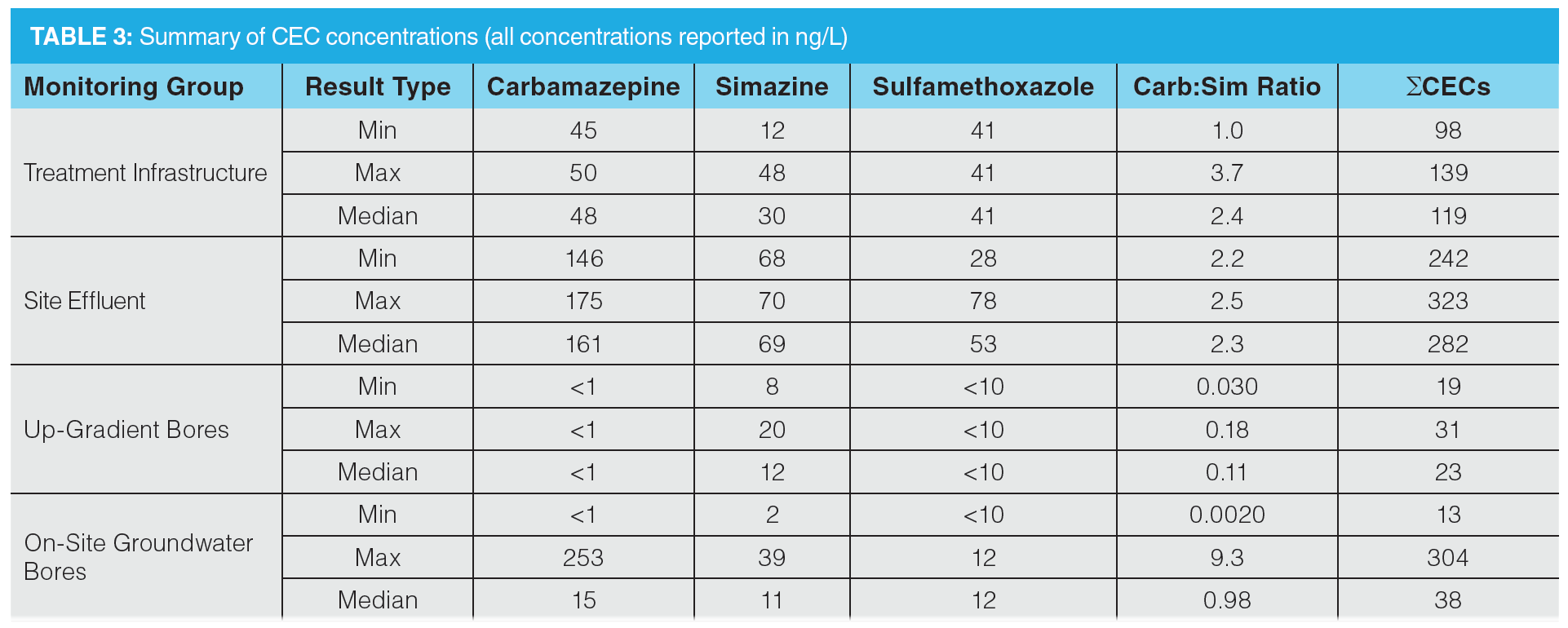
Site effluent had an elevated concentration of all CEC compounds (carbamazepine, simazine, and sulfamethoxazole), with a median ∑CECs of 282 ng/L, compared to treatment infrastructure (median ∑CECs of 119 ng/L) and on-site groundwater (median ∑CECs of 38 ng/L).
Groundwater bores located down‑gradient of the WWTP recorded elevated concentrations of carbamazepine (ranging from 20 to 252 ng/L) compared to the remaining on-site groundwater bores (ranging from <1 to 15 ng/L). Up-gradient bores reported concentrations below the limit of quantification (LOQ) in all cases.
Groundwater bores upstream of the WWTP recorded elevated concentrations of simazine (ranging from 14 to 39 ng/L), compared to the remaining on-site groundwater bores (ranging from 2 to 12 ng/L). Up-gradient bores also reported detectable simazine concentrations ranging from 8 to 20 ng/L. This suggests both an up-gradient source of simazine in the region, perhaps related to agricultural land uses or potentially the use of recycled water, as well as some additional input related to the WWTP. This is consistent with previous work that suggests wastewaters can be an important source of pesticides in the aquatic environment (12). This may occur due to spills or disposal of excess pesticides into sewer networks or groundwater infiltration into shallow sewer pipes. Use of recycled water for irrigation can lead to this water, and any associated CECs, percolating down to the groundwater system. Similarly, agricultural chemicals are often present in domestic sewage; sources can include run-off from domestic gardens and housing developments, and incorrect disposal to storm drains.
The compound with the highest source specificity was carbamazepine, which was found to be more diagnostic of WWTP impacts compared to the herbicide simazine, which came from agricultural and wastewater-derived sources (12). The relatively lower detection frequency of sulfamethoxazole may have been due to the complex sample matrix (groundwater, site effluent, and partially treated effluent). In other sites, the CECs from wastewater and agriculture will likely differ depending on the catchment. For example, simazine is banned or regulated in some countries (though not Australia) so likely won’t be found in groundwater in such places, though other pesticides would be present instead.
The CECs likely to be present in wastewater at a specific site or area can often be identified based on the knowledge of what chemicals are used in the catchment and can be included by a water utility’s own routine on-site monitoring and/or compliance testing. The best way to find out the likely agricultural chemicals to be present in a specific agricultural area (assuming there is no background data available) is to look at the sales data from the local suppliers, or alternatively look at what crops are grown in the local area and determine the most commonly used pesticides for those crops. These data can save significant time undertaking untargeted analysis but are not always easy to come by.
Given the complex site history (that is, different contaminant sources over time), ubiquitous occurrence of simazine in the groundwater environment, and likely source specificity of carbamazepine, the ratio of carbamazepine to simazine (carb:sim ratio) was used as a novel way to delineate the wastewater-derived impacts from those of agriculture and/or recycled water use.
The carb:sim ratio was found to vary across the site, with treatment infrastructure and site effluent reporting the highest median ratios of 2.4 and 2.3, respectively, compared to that of on-site groundwater bores (median of 0.98) and up-gradient groundwater bores (median of 0.11). Groundwater bores located adjacent to or down-gradient of the treatment assets generally exhibited elevated ratios, ranging from 0.62 to 9.3 (median of 2.8), compared to the remaining on-site groundwater bores, which ranged from 0.002 to 0.50 (median of 0.082). As such, the pharmaceutical carbamazepine was clearly elevated relative to the herbicide simazine in samples down‑gradient of the WWTP, allowing for distinct source separation (where nutrient concentrations were ambiguous on their own). This is illustrated in Figure 3.
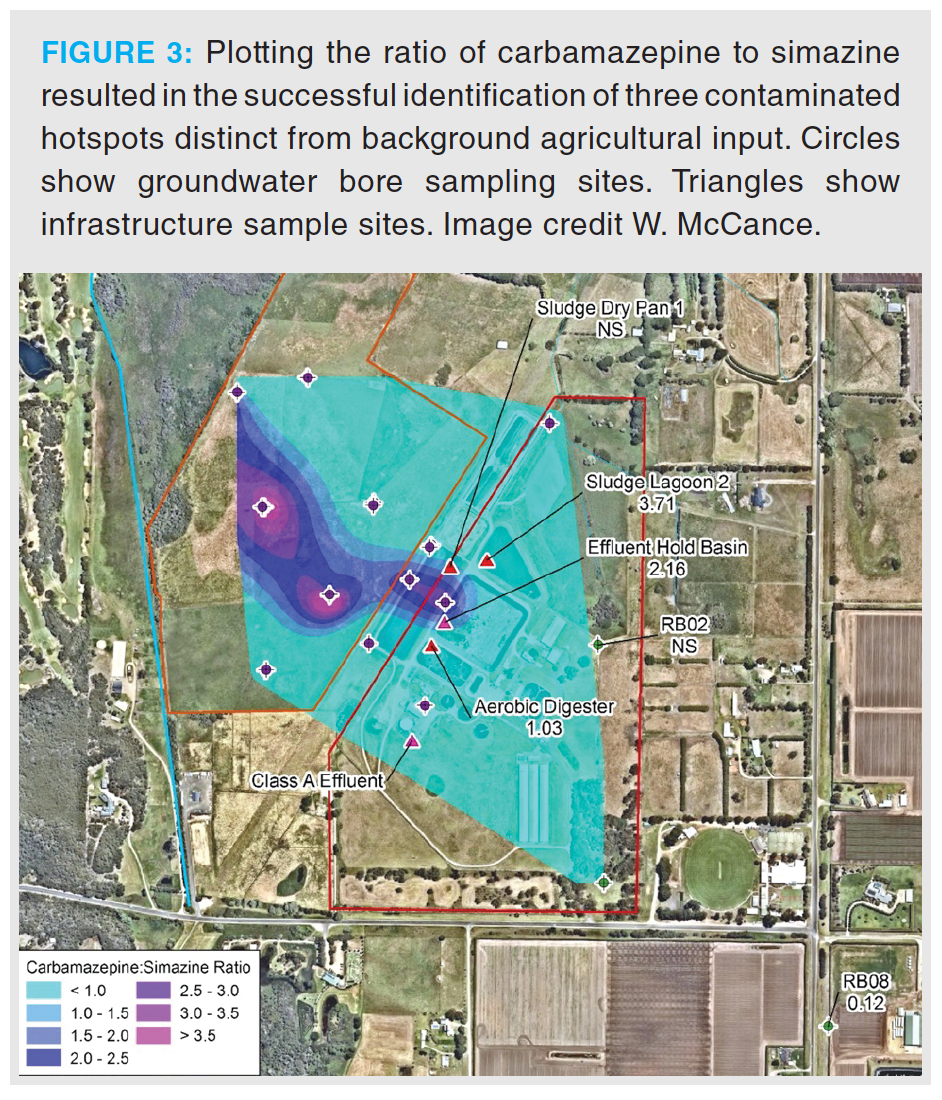
As shown in Figure 3, the carb:sim ratios suggest the existence of three contaminant “hot spots”; two located down-gradient of the site—consistent with historical impact that has since migrated a significant distance from the WWTP—and one stemming from the current treatment assets—reflecting recent impacts. Ratios in the down-gradient “hot spots” (ranging from 2.7 to 9.3) were particularly elevated relative to those directly adjacent to or down-gradient of current treatment infrastructure. This suggests differences in the relative input of these compounds over time (assuming both compounds behave relatively conservatively), which is consistent with the site development timeline and possibly a reflection of changes in effluent composition following infrastructure upgrades. The novelty of this work is that a) specific CEC ratios can be used for pollution source differentiation, and b) the data you can then acquire about groundwater impacts helps to inform management practices once sources are differentiated. The findings have significant implications for future remedial actions, if required, and provide a method with which to further separate the regional agricultural impacts from WWTP site-derived impacts.
There is also the question of whether the contaminant plume is of environmental concern as well as a useful marker of wastewater impact on groundwater. The greater Melbourne area ultimately drains into Port Philip Bay (a horse head-shaped enclosed bay on the central coast of Southern Victoria, with the city of Melbourne located on the northern tip). If we assume that all the CECs in the groundwater plume ended up in Port Philip Bay and the contribution/leakage from the plant was also constant, then given the groundwater flow rate and the concentrations of CECs we can ask what would be the contribution of the plume of each CEC per year to the bay?
Based on groundwater discharge estimates from C.J. Otto in 1992 (the most recent data), groundwater discharge to Port Phillip Bay is estimated at 5.5 × 107 m3/year (13). The estimated seepage velocity of the groundwater is 13–95 m/year and there is a distance of approximately 5 km to the bay from the WWTP. This means it would take between 52 and 384 years for the contaminants to reach Port Phillip Bay—assuming no degradation or other interactions are occurring (whereas in reality, the plume will likely undergo significant dilution and/or mixing as it travels towards the bay and the contaminants will likely be subject to some biodegradation).
So, at this point, it’s likely these CECs would not have impacted the bay as yet, unless the groundwater contributes to surface water features (such as creeks), which can transport contaminants much faster.
Conclusions
The contamination of land and groundwater resources creates a potentially major public health and environmental burden on current and future generations. Accurately identifying the sources, pathways, and impacts of groundwater contamination can be highly challenging due to complex geology, land use, and biogeochemical processes in aquifers. By working with Victoria’s water industry and other partners, this project developed new techniques to identify and separate groundwater contamination arising from different sources within complex environments. A method to distinguish contamination from wastewater treatment plants and intensive agriculture was developed, combining the analysis of trace micropollutants with groundwater monitoring and knowledge of background hydrology.
The use of novel groundwater tracers, particularly the carbamazepine:simazine ratio, was found to provide greater insight into the nature and extent of a groundwater contamination plume. This was particularly useful in constraining potential historic (“legacy”) impacts from more recent site-derived impacts, which was not possible using conventional methods and/or environmental tracers alone.
This approach not only assisted in discriminating between up-gradient and site-derived impacts but also provided insights into historic (“legacy”) and more recent contamination sources and their changing characteristics. The results were consistent with the existence of multiple on-site sources, with differing timescales and source concentrations. This work has enhanced the outcomes of routine monitoring and enabled a better understanding of the nature and extent of groundwater impacts, enabling ongoing monitoring, management, and remedial actions to be suitably targeted. The project has also provided wastewater treatment plant operators and practitioners with a set of tools to help to better identify contamination in complex environments, and demonstrated the essential contribution that high-end chromatography and mass spectrometry make to modern environmental science and management.
Funding Source
Cooperative Research Centre for Contamination Assessment and Remediation (CRC‑CARE). Grant no. 2.3.02.
Acknowledgements
The authors would like to thank CRC CARE, Gippsland Water, Melbourne Water, South East Water, and Western Water for their funding and support in undertaking this work.
References
- G.M. Sinclair, S.M. Long, and O.A.H. Jones, Chemosphere 258, 127340 (2020).
- L. Alexandrou, B.J. Meehan, and O.A.H. Jones, Science of The Total Environment 637–638, 1607–1616 (2018).
- Z. Tian, H. Zhao, K.T. Peter, M. Gonzalez, J. Wetzel, C. Wu, X. Hu, J. Prat, E. Mudrock, R. Hettinger, et al., Science 371, 185–189 (2021).
- C. Hignite and D.L. Azarnoff, Life Sci. 20, 337–341 (1977).
- A.D. Canning, M.K. Joy, and R.G. Death, PeerJ 9, e11556 (2021).
- W. McCance, O.A.H. Jones, M. Edwards, A. Surapaneni, S. Chadalavada, and M. Currell, Water Research 146, 118–133 (2018).
- L. Wolf, C. Zwiener, and M. Zemann, Science of The Total Environment 430, 8–19 (2012).
- W. McCance, O. Jones, A. Surapaneni, and M. Currell, Water e-Journal 5, (2020).
- W. McCance, O.A.H. Jones, D.I. Cendón, M. Edwards, A. Surapaneni, S. Chadalavada, and M. Currell, Science of The Total Environment 774, 145781 (2021).
- W. McCance, O.A.H. Jones, D.I. Cendón, M. Edwards, A. Surapaneni, S. Chadalavada, S. Wang, and M. Currell, Water Research 182, 116036 (2020).
- D.R. Van Stempvoort, J.W. Roy, J. Grabuski, S.J. Brown, G. Bickerton, and E. Sverko, Science of The Total Environment 461–462, 348–359 (2013).
- M. Köck-Schulmeyer, M. Villagrasa, M. López de Alda, R. Céspedes-Sánchez, F. Ventura, and D. Barceló, Science of the Total Environment 458, 466–476 (2013).
- C.J. Otto, CSIRO Port Phillip Bay Environmental Study, Technical Report No. 4 (Melbourne, Australia, 1992).
Oliver Jones is Professor of Analytical Chemistry at RMIT University. His research expertise is in the field of analytical biological and environmental chemistry with interdisciplinary applications in biology, environmental science, water technology, and forensic science. He is particularly interested in tracking the fate and behaviour of pollutants in the environment.
Matthew Currell is Associate Professor of Environmental Engineering at RMIT University and a leading researcher in the field of hydrogeology and geochemistry. He has published more than 60 peer-reviewed journal articles, been cited more than 2000 times, and has served on the editorial board of the Hydrogeology Journal.
William McCance is an environmental engineer and scientist with over seven years of experience in environmental consulting working principally in the solid waste, wastewater, and contaminated land management fields. Will recently completed his Ph.D., focusing on the identification and application of novel groundwater tracers in delineating wastewater‑derived impacts from other sources.
In the present study, a gradient reversed-phase high-performance liquid chromatography (RP-HPLC) method has been designed and validated to quantify ornidazole (OZ) in the marketed formulation (oral gel) with the application of QbD.
A column with chemically modified column hardware showed improvements in analytical performance for siRNA compared to a conventional stainless-steel column.

.png&w=3840&q=75)

.png&w=3840&q=75)



.png&w=3840&q=75)



.png&w=3840&q=75)
